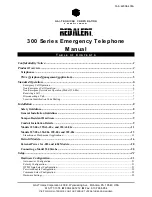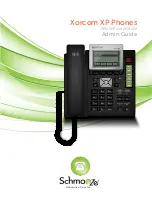
P
UB
42004-438A
300
S
ERIES
E
MERGENCY
T
ELEPHONE
M
ANUAL
P
AGE
6 of 44
f:\standard ioms - current release\42004 instr. manuals\42004-438a.doc
02/11
Standard Operation
Four types of telephones are described in this manual:
•
Single emergency push-button operation (autodial)
•
Emergency push button and call push button with keypad
•
Emergency push button and assistance push button (both autodial)
•
Call push button with keypad (hands-free standard telephone operation)
This section describes the general operation of each telephone type.
Emergency Call Operation
N
OTE
:
Applicable to telephones equipped with an
EMERGENCY
push button.
1.
Press the
EMERGENCY
push button to place an immediate call to a pre-programmed emergency
telephone number; typically a security office, campus police, or 911.
2.
The
C
ALL
R
ECEIVED
W
HEN
L
IT
indicator (LED) can be configured to operate in either of the
following two ways:
•
The indicator will begin to flash when the
E
MERGENCY
push button is pressed and will light
(steadily) when the telephone detects audio after the call is answered.
•
The indicator will begin to flash when the
E
MERGENCY
push button is pressed and will light
(steadily) when the called party acknowledges receiving the call by transmitting a DTMF “#” or
“*” after answering the call.
3.
Two-way, hands-free conversation can now occur.
Non-Emergency Call Operation
N
OTE
:
Applicable to telephones equipped with a
CALL
push button and keypad, with or without an
EMERGENCY
push button.
The phone models with keypads can also be used to make non-emergency type calls as follows:
1.
Press the
CALL
push button (dial tone can be heard over the speaker).
2.
Use the keypad to dial the desired number.
3.
Press the
CALL
push button upon completion of the call (hang up).
N
OTE
:
The
CALL
push button can be configured to auto-dial, thereby overriding the keypad dialing
feature. This operation can be used to call a central telephone number and use the keypad to make feature
selections.









































